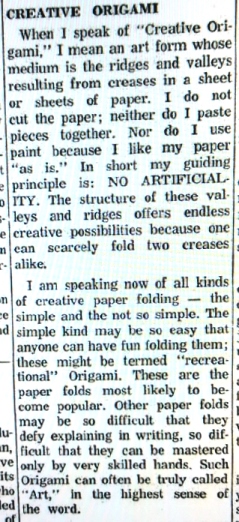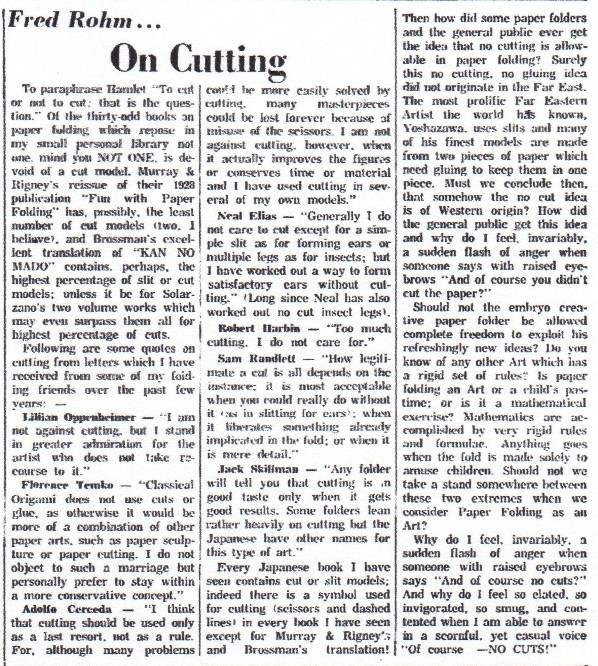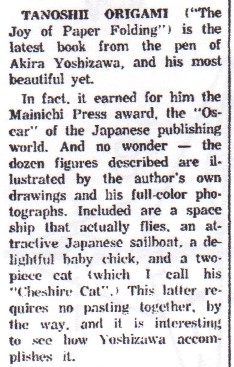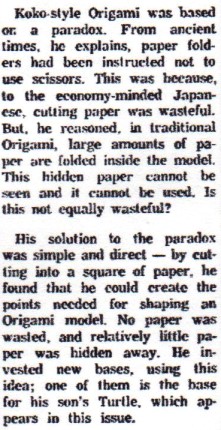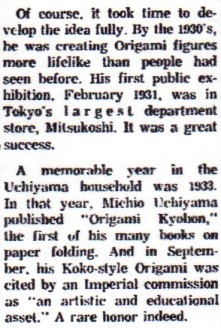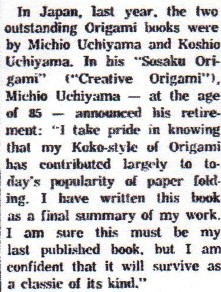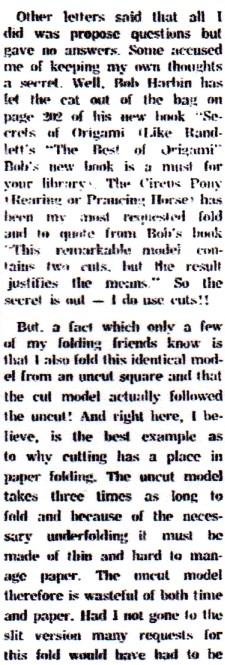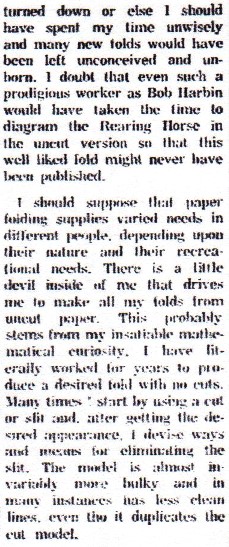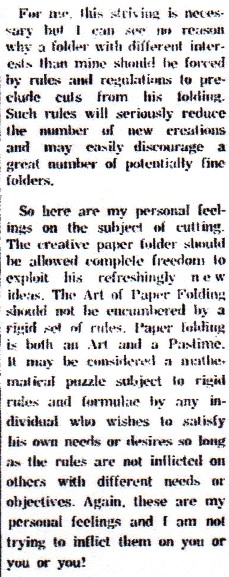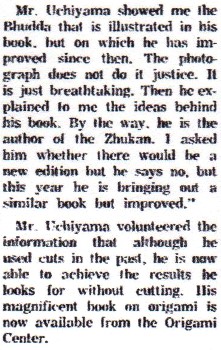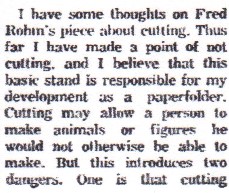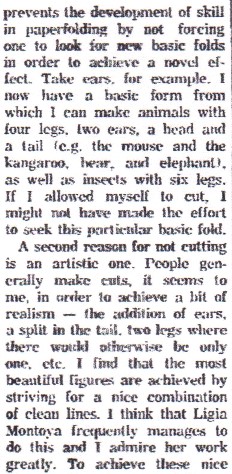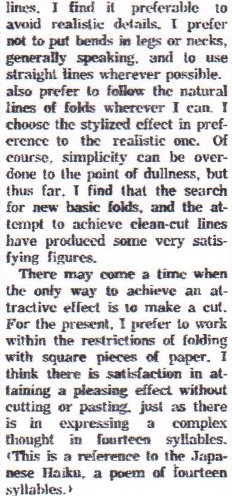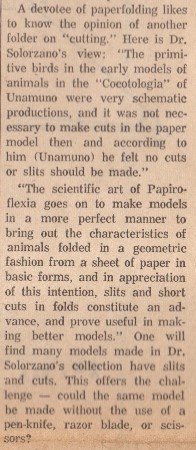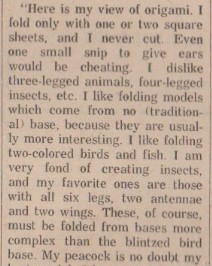| The Public Paperfolding History Project
Last updated 15/5/2025 x |
|||||||
| Pure Origami | |||||||
| This
page is being used to collect material that bears on the
origin and development of the concept of pure origami,
the idea that origami designs should be created by
folding alone and not by the use of / with the addition
of cuts, glue or decoration. ********** 1928 An article titled 'Miguel de Unamuno - der Baskische Bildhauer' (the Basque Sculptor) by Edda Reinhardt, was published in Berlin in the avante-garde magazine 'Der Querschnitt' in October 1928. Within this article Unamuno is quoted as saying, translated into English by Edwin Corrie, 'You have to be very careful, because of course you’re not allowed to use scissors or glue. In Paris there was a Japanese man who made some really pretty things – but he cut and glued them! No, no, you mustn’t glue and cut – that’s not art – if you do, then the form does not come out of the surface. No, no – just folding – and first here, in your head, break down the form. Project each limb – head – belly – back – onto the surface and then think back again, so that the surface is not interrupted. And convert everything that’s rounded into straight lines: that’s why the pig is so difficult!” ********** 1932 'Estampa' magazune of 3rd December 1932 carried a two page article about Unamuno's paperfolding which includes a brief passage about his paperfolding ethics. Roughly translated 'The master's own fingers, feverish, tireless, kneading surfaces, making folds, seeing folds, making from a square of paper, without cutting, without gluing, without adding, this is the essential!' ********** 1936 The final sentence of the introduction to 'Faltarbeiten aus Papier 1' (Paperfolding Work) by Georg Netzband, which was published by W Kohlhammer Verlag in Stuttgart and Berlin in 1936 as a handbook to accompany educational film F57says: 'It is important that as little as possible is cut, and as little as possible is glued, when folding.' However, the film which accompanies the book shows simple details being drawn onto the folded designs. ********** 1941 'Papiro-Zoo: Manual practico de cocotologia o papirologia' by Giordano Lareo, which was published by Larco in Buenos Aires in 194, contains a Prologo by Eduardo Blanco-Amor which is notable for its statement, which expresses an idea presumably learned from the main author. 'The fundamental thing about papyrology ... consists in not cutting and pasting. ... Anything other than this is vile fraud. Beware students of papyrology! Do not cut and do not paste!'
********** 1944 In the 1944 second edition of 'Papiro-Zoo: Manual Practico de Papirologia o Cocotologia', the author reiterates the opposition to cutting and glueing found in the Prologo to the first edition. Roughly, 'The fundamental thing in the resolution of this problem is not to cut or paste any part of the paper that is to be used for the construction of the figure. Anything that goes beyond this rule is neither more nor less than cheating. ... The use of scissors or glue not only distorts the art itself but also paperfolding would lose much of its pedagogical value.' ********** 1954 In Yoshizawa's English Introduction to his book 'Atari Origami Geijuitsu', which was published by Origami Geijutsu Sha on 1st April 1954, he says:'I have avoided the use of scissors because I did not want my Origami works to transgress beyond the field of “paper folding”. The art of Origami should be differentiated from pure paper cutting. I did not color the patterns nor did draw lines on them, that is. I did not add eyes and noses on the face part of my patterns. All of such additional touches deprive the Origami art of its symbolic beauty.' (Note, however, that the crest of the Compound Peacock appears to be made using a cut. Also note that several of the designs are glued together, something that in Yoshizawa's view clearly does not deprive the designs of their symbolic beauty.) ********** 1959 An article in the Australian newspaper The Age for 30th July 1959 contains mention of the ethics of paperfolding in Japan, stating, inter alia, that 'Purists frown on the use of scissors ...' and that 'Paste is permitted ...' ********** The introduction to 'Fun-time Paper Folding' by Elinor Tripato Massoglio, which was published by Childrens Press in Chicago in 1959, says 'According to tradition, the paper must not be cut or pasted and the object should be folded from a single piece', which is interesting precisely because it is not true. It is also interesting to note that despite this statement the 'Swan' is heavily cut. Several drawings of the finished designs show them enhanced with drawn on eyes and other details. ********** 1960 An article about origami in The Australian Women's Weekly of 23rd March 1960 contains the statement 'And it's done without scissors.' ********** 1961 Philip Shen is featured in an article published in the Chicago Daily Tribune of 25th June 1961, which, inter alia, mentions, and defines, 'pure' origami. ('lfat' presumably means 'flat'.)
********** 1962 Volume 2 Issue 3 of 'The Origamian' for Spring / Summer 1962 contained a letter from Fred Rohm saying of Neal Elias 'He apparently dislikes any cutting so his folds are rather complex ...' The same issue also mentions Neal Elias' latest fold 'a Tiger with no cutting to make the ears. This is made by one by one and a half rectangle.' ********** 1963 Vol 3: Issue 3 of the Origamian for Autumn 1963 contains an article by Akira Yoshizawa on 'Creative Origami', which was originally published in Kokusai Bunka magazine in January 1961. This states, inter alia:
********** Vol 3: Issue 4 of the Origamian for Winter 1963/4 contains an article by Fred Rohm, 'On Cutting'.
*** The same issue contains a review by Lillian Oppenheimer of 'Tanoshii Origami' by Yoshizawa which mentions that it contains a compound figure which holds together without the need for glue.
********** 1964 A profile by Peter Van Note of 'three generations of paperfolders - the family Uchiyama' - grandmother, father and son - appeared in Vol 4: Issue 1 of 'The Origamian' for Spring 1964 which explained the thinking behind his heavily cut style of origami:
*** Vol 4: Issue 2 of 'The Origamian' for Summer 1964 contains a follow-up article 'More About Cutting' by Fred Rohm:
*** The same edition of 'The Origamian'contains a report of 'A Paperfolder's Trip to Japan' by Florence Temko, which describes her meeting with Koshio Uchiyama.
********** Vol 4: Issue 4 of 'The Origamian' for Winter 1964 contains a profile of James M Sakoda written by Alice Gray, much of which is directly quoted from one of his letters, which gives his views on cutting:
********** 1965 Vol 5: Issue 3 of 'The Origamian' for Autumn 1965 contained a review of 'Papiroflexia Zoomorphica', written by Francis K McNaul Jr, which, inter alia, also gave information on Solorzano's view of the use of cuts:
********** 1966 An Article about Yoshizawa in The CanberraTimes, February 1966 states:
********** 1968 The Introduction to 'Your Book of Paperfolding' by Vanessa and Eric de Maré, which was published by Faber and Faber in London in 1968, says that in Japan 'The simple folded object is considered to be superior to that which is cut or glued.' However, the authors do not appear to have taken this philosophy on board.
********** 1969 Vol 9: Issue 2 of 'The Origamian' for Summer 1969 contained an article (in two parts) on 'Strengthening and Protecting Origami Exhibition Pieces' by Mark Medvene (part 1) and Francisco del Rio (part 2) about the use of laquer to protect finished paperfolds. ********** Vol 9: Issue 3 of 'The Origamian for Autumn 1969 contained a profile of John Montroll, then 16, written by Alice Gray, which includes some brief information on his paperfolding ethics:
********** There is a discussion of the current state of paperfolding ethics in 'Modern Origami' by James Minoru Sakoda, which was published by Simon and Schuster in New York in 1969. ********** 1970 An article by Robert Harbin in Woman's Own magazine of March 1970 stated 'Each example, whether plain or fancy, started as a simple piece of paper - no scissors or paste.' ********** |
|||||||

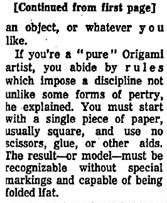 .
.